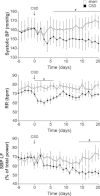Hypertension is critically dependent on the carotid body input in the spontaneously hypertensive rat
- PMID: 22687617
- PMCID: PMC3473284
- DOI: 10.1113/jphysiol.2012.237800
Hypertension is critically dependent on the carotid body input in the spontaneously hypertensive rat
Abstract
The peripheral chemoreflex is known to be enhanced in individuals with hypertension. In pre-hypertensive (PH) and adult spontaneously hypertensive rats (SHRs) carotid body type I (glomus) cells exhibit hypersensitivity to chemosensory stimuli and elevated sympathoexcitatory responses to peripheral chemoreceptor stimulation. Herein, we eliminated carotid body inputs in both PH-SHRs and SHRs to test the hypothesis that heightened peripheral chemoreceptor activity contributes to both the development and maintenance of hypertension. The carotid sinus nerves were surgically denervated under general anaesthesia in 4- and 12-week-old SHRs. Control groups comprised sham-operated SHRs and aged-matched sham-operated and carotid sinus nerve denervated Wistar rats. Arterial blood pressure was recorded chronically in conscious, freely moving animals. Successful carotid sinus nerve denervation (CSD) was confirmed by testing respiratory responses to hypoxia (10% O(2)) or cardiovascular responses to i.v. injection of sodium cyanide. In the SHR, CSD reduced both the development of hypertension and its maintenance (P<0.05) and was associated with a reduction in sympathetic vasomotor tone (as revealed by frequency domain analysis and reduced arterial pressure responses to administration of hexamethonium; P<0.05 vs. sham-operated SHR) and an improvement in baroreflex sensitivity. No effect on blood pressure was observed in sham-operated SHRs or Wistar rats. In conclusion, carotid sinus nerve inputs from the carotid body are, in part, responsible for elevated sympathetic tone and critical for the genesis of hypertension in the developing SHR and its maintenance in later life.
Figures




Comment in
-
The carotid body in cardiovascular disease: more chicken and egg than horse and cart?J Physiol. 2012 Sep 1;590(17):4123. doi: 10.1113/jphysiol.2012.239921. J Physiol. 2012. PMID: 22962032 Free PMC article. No abstract available.
References
-
- Abdala APL, Marina N, Gourine AV, Paton JFR. Peripheral chemoreceptor inputs contribute to the development of high blood pressure in spontaneously hypertensive rats. Proc Physiol Soc. 2011a;23:PC22.
-
- Abdala APL, Paton JFR, Gourine AV. Peripheral chemoreceptor (PC) inputs contribute to the development of high blood pressure in spontaneously hypertensive rats (SHR) FASEB J. 2011b;25:640.10.
-
- Abdala AP, Schoorlemmer GH, Colombari E. Ablation of NK1 receptor bearing neurons in the nucleus of the solitary tract blunts cardiovascular reflexes in awake rats. Brain Res. 2006;1119:165–173. - PubMed
-
- Anderson EA, Sinkey CA, Lawton WJ, Mark AL. Elevated sympathetic nerve activity in borderline hypertensive humans. Evidence from direct intraneural recordings. Hypertension. 1989;14:177–183. - PubMed
Publication types
MeSH terms
Grants and funding
LinkOut - more resources
Full Text Sources
Other Literature Sources
Medical

